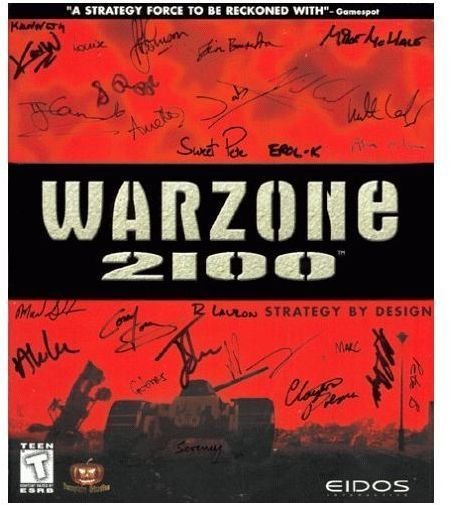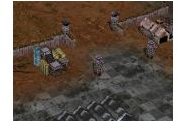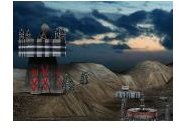Ten Years Later, the New, Improved, Open Source Warzone 2100

Introduction to Warzone. A Brief History.
Warzone 2100 was a game released to the public in 1999, back when the average RTS was either in two demensions, or just barely i
n three without setting your PC on fire.
Today, as a re-release in the open source phase, you could probably run ten of these instances at once without your average gaming rig breaking a sweat. This is being reviewed because
1. It, being recently released in Open Source, offers us the moment to look into a very popular old game.
2. The game is hitting its tenth anniversery, giving a great chance and timing for it to be reviewed ten years later.
Did I also mention I’ve been unsatisfied with every recent RTS release and have resorted to playing games that I still find decent enough in design to get past the first few levels.
And now, a short plotline.
The Warzone 2100 Plotline
Warzone 2100 is a Post Apocalyptic Real Time Strategy Game that takes place in the former United States. The year is 2100, and as the story goes, a system, known as NASDA, designed to protect the world, goes haywire and brings them into the post apocalyptic Stone Age. Many die, and the majority of the few who survive revert to clan-like scavenger societies. A small group, finding safety within the Rocky Mountains, decides to rebuild from the ruins, and collect artifacts of their past world. They form what is known as the Project.

The Project divides itself into three teams within the United State by the area they cover. You, the Commander of Team Alpha, eventually get to take charge of each team and lead them to success.
Team Alpha - The Southwest (Arizona - Nevada)
Team Beta - Central/North East ruins (Chicago specifically)
Team Gamma - Northwest US/ Southwest Canada (Rocky Mountains and Upper Snowy Regions)
Although the Project seeks good, there are also groups you will encounter that seek the opposite, including Scavengers, The New Paradigm, The Collective, and even NASDA itself (as NeXus)
For a RTS, it has a dense storyline, one that does not even need to borrow from modern history except in the form of Nuclear Paranoia.
Now, onto the meat of this game. It’s Mechanics, User Interface, and even the bits of Customization!
Gameplay Mechanics
In most current Real Time Strategies, you have often 2-4 different resources that you must manage in order to maintain your base, forces, and other goods. Instead of this setup, Warzone 2100 follows a very simple approach: Oil.
Or rather, the energy you draw from power.
Everything in the game, from your buildings, to units, to research, is projected not by necessary goods, but rather but a - or + remaining power following the process’s beginning to completion, based on your current power. This single resource is shown by a bar on the bottom of the screen, that grows and shrinks based on what you are doing that will suck that power, your incoming powe

r from your oil derricks, and whatever stores you have remaining. Everything in the game relies on power management. Don’t expect the computer to do it for you, this is not Sim City. You must stop, and continue processes (by clicking them when they are in action) to manage power, to make sure you always are properly distributing your power for vehicles, research, and buildings. This occurs anytime you run out of stockpiled power, at which point you rely only on what is coming in, which if you do not manage, is distributed evenly to each running process.
Although it seems a little bothersome to some, this grows the strategy aspect, requiring you to manage your resources if you are preparing to fight a player, or build your defenses, meanwhile ensuring you stay ahead in research.
User Interface & Customization
Do you want to see EVERYTHING you can possibly see on a battlefield? Well with Warzone, you practically can. There is only ONE menu bar visible on the screen, which is on the left side and changes based on a 7 button hexagon shape. They are handily organized into (from top going clockwise and lastly the center button):
Productions [Units]
Research
Building / Constructions
Development (Designing your own Units)
Archive [Past Researches and further information]
Command [ Only available after research and owning Command units]
Close [The center symbol for closing the lefthand menu]
Besides this, you get a power bar, and minimap (only visible if you have an HQ built). There are no further items on your UI, making it both clean and easy to read.
Please note that this game is very LIGHT on toolbars/information bars. Most of it is done by the minimap or by sound, with the occasional prompt on top. Detailed information on units and buildings is inside the Archive button mode.

Customization, in the late game (Singleplayer or Skirmish) is unbelievable. Remember that design mode we mentioned? It’s there for a BIG reason. For every unit, you can decide its wheels/treads, body, and components. This leaves you with hundreds of combinations to offer you a wide range of land and air units to test and build the best strategy out of. Stats below the created unit offer information on what your unit is good and bad at doing.
The game, even for 10 years old, would have everything you’d want to prevent the annoyances an RTS can create. Looping unit productions, using a loop button in the menu, allows the entire production process to repeat itself between 1 and infinity times, so you will always have fresh troops meanwhile giving your mouse a break.
Last but not least, we will have the actual gameplay experience
The Gameplay Experience
The developers thankfully have made some repairs that the game needed over the years. In the original Warzone, especially by today’s standards, AI was hardly Intelligent. Units easily got stuck on walls, and failed to show any interest in attacking you, their sworn enemy. With the countless hours of improvements and upgrades under the hood of this Open Source reconstruction, the AI has become much more hostile and tricky, making the game a greater challenge.
Losing is far from the average experience of failing an objective, or having your base destroyed. Instead, you will usually have a small chance of losing your base, but have a bigger problem of not meeting the time limits. The missions range from 5 to 60 minutes in time limit, giving you only so much time before you will be closed out of your game with the “Mission Failed” alert. It’s an interesting approach, as you need to manage your resources, units, and time all at once: out of balance anywhere, and your plans fall apart.
The COMMAND units are a great addition to the game. These units, with special “Command” modules, control your forces and allow you to easily command attacks, manage retreating, recycling, repairs, and even production (new units drive directly to your command module). These, although having little offensive value themselves, organize battles greatly.
The Storyline, with vivid and detailed cutscenes, are all dated to its 1999 release. The only additions are minor pieces of art and texture upgrades. But for the most part, you will experience some grainyness especially with the larger screens. However, it is far from unenjoyable. Just… good luck reading all the little dots on your minimap.
I’d like to note we have, in this entire game, three songs. This game is not unfinished, it was just apparently not a priority to have a lot of music. If you get bored of it, as I did, I suggest you play some background music instead: some Nine inch Nails is always an interesting alternative to the similar music they put in the game.
Despite the slight grainyness and the poor variety in music. Warzone 2100 is a great game for 1999, and 2009!
Conclusion
My conclusion? BUY IT! Download it for free! (may I add with your Windows, Mac, or Linux PC. That’s right, this game has become both open source and cross platform.)
It’s got some buggy AI, but they can put up quite the challenge. A Simple UI, and easy load on the processor means it work on virtually any vaguely modern XP - 7 / Linux / Mac PC, which gives it a great opprotunity to liven up the night, even if away from home on an underpowered mobile computer. The storyline is fantastic for even today’s (somewhat low) standard, all without the great Graphics, voice actors, or other things we’ve gotten used to in the last decade.
Now let me note here, these developers did A LOT with this game. When it came from the original developers (Pumpkin Studios), it was pretty much incompatible with Vista without some serious under the hood improvements, and also added personal art and items they felt could improve its gameplay, and have immensely.
If you have any questions about this game, head on over to the developers site.
If you want to leave me feedback, you can email me [here](https://mailto: [email protected]) or use the comments below.

